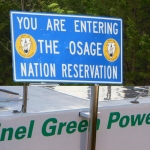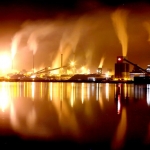US: Crude spill shuts down Slope plant
Leak discovered by BP worker may have covered five acres.
Crude oil leaking from a major North Slope pipeline might have oozed over 3 to 5 acres of frozen, snow-clad tundra, prompting a major cleanup effort Thursday, an oil company spokesman said.
The leak forced the shutdown of an oil-processing plant and about 245 wells in the giant Prudhoe Bay field, cutting Slope production by about 12 percent, or 100,000 barrels per day. At Thursday's closing oil price of $60.81, the interrupted oil flow is worth more than $6 million daily.
State pollution regulators and cleanup crews from BP Exploration (Alaska) Inc., which runs Prudhoe, rushed to the spill site after a BP worker driving along a gravel road parallel to the pipeline at 5:45 a.m. Thursday saw and smelled crude oil on the tundra.
Aerial photos released jointly by BP and the state Department of Environmental Conservation showed a squiggly trail of oil running north from the large, above-ground pipeline, which is 34 inches in diameter.
Neither state officials nor BP spokesman Daren Beaudo could say how much oil was spilled.
But Beaudo said two trucks sent to vacuum up the oil had recovered 62 barrels of liquid as of Thursday afternoon. The company had to apply for a special permit from the state to allow the trucks to drive on the delicate tundra.
Corrosion is a constant threat to the Slope's spaghetti network of steel pipelines, causing many leaks in the past, and it's possible the pipeline developed a hole some time ago and was slowly leaking oil.
Beaudo said he didn't want to speculate on a cause, however, until workers peel back insulation and snowdrifts that partially cover the pipe and take a closer look. He did say, however, that the leak was not the result of, for example, a vehicle smashing into the line.
BP sent up an airplane equipped with an infrared camera to try to measure how widely the oil had spread. The oil is hot when it comes out of the pipeline, 180 degrees on average, but it cools and thickens when it hits the tundra, Beaudo said.
The pipeline carries crude oil from a processing plant called Gathering Center 2, on the western side of the Prudhoe field, about six miles to Pump Station 1, the starting point of the 800-mile trans-Alaska oil pipeline.
Prudhoe Bay is the country's largest oil field.
After the leak was discovered, BP shut down the gathering center, which separates the raw mixture of crude oil, natural gas and water piped in from the wells. From the center, the crude oil flows away in the 34-inch line.
The leak occurred just east of the gathering center, at a point where the pipe rests on a bracket that holds it a few feet off the ground.
BP workers plugged the line on either side of the leak to prevent more oil from spilling.
Ed Meggert, a DEC official in Fairbanks, said snow might be concealing the full size of the spill, which had reached a frozen lake north of the pipeline. Scores of lakes dot the North Slope tundra.
"We just know there's a fairly large pool out there," he said.
Weather was both friend and enemy to cleanup workers.
On one hand, the snow cover and frozen ground should help prevent oil from seeping into the tundra, killing plant life. But with temperatures reaching to 25 below zero Thursday night, plus a stiff breeze, BP wants to make sure workers have the right equipment and aren't exposed, Beaudo said.
Early on Thursday, spill responders stayed away from the pipeline because of dangerous fumes in the air.
Beaudo couldn't say how long the wells and gathering center will be out of service and the oil flow reduced. He also said it's hard to say how long the cleanup might take.
Workers plan to strip away snow from 3 to 5 acres to get at the spill, Beaudo said.
The frozen ground increases the chances of a full cleanup, he added.
"We can't say for certain, but it's our experience that we can get 100 percent of the oil cleaned up and that the tundra may not be impacted at all," he said. "That's our goal."
Because of its size, the leaky pipeline can accommodate a pig, which is a bullet-shaped device that slides down pipes to sense for weak spots in the steel wall or other problems.
The line had been pigged, but Beaudo could not provide details on whether any problems had been found.
The DEC sent two people to the oil field Thursday and planned to send four more today.
Daily News reporter Wesley Loy can be reached at wloy@adn.com or 257-4590.
- 107 Energy



